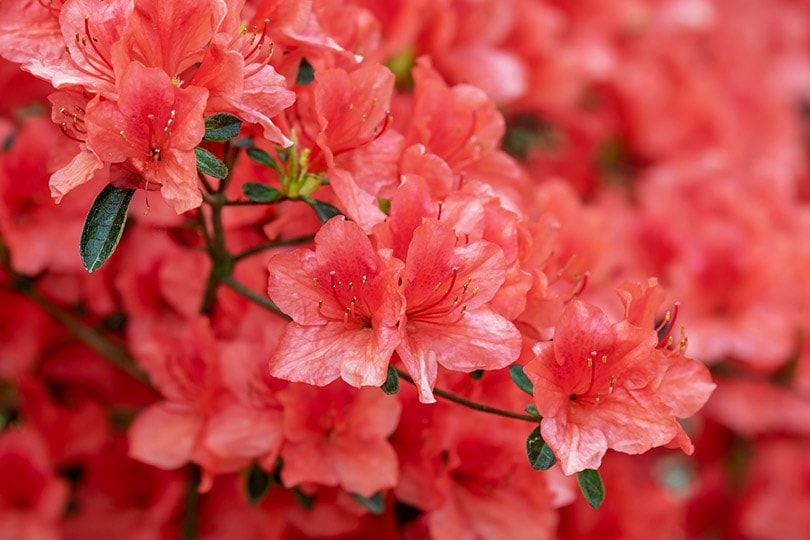When Do Azaleas Bloom? How Long Is the Season
-
Pete Ortiz
- Last updated:

Azalea flowers are one of the first signs of spring and can bloom for weeks or months. The bloom time of an azalea can vary or be affected by things like care and maintenance, weather, and pests. While azaleas typically bloom from late March to the middle of May, they can bloom again in the summer and through the fall. There are instances, however, when your azalea bush may not bloom at all.
Azalea Basics
If you are planning to grace your landscape with an azalea plant, plan to give it a bit of attention if you want to produce beautiful vibrant flowers. Water, sun, and temperature can affect the bloom time and the number of flowers produced by your azalea plant.
Bloom Contributors
- Care and Maintenance: Although azaleas bloom in their own time, the care and maintenance you provide will affect the size, color, and number of blooms the plant produces.
- Weather: The weather is also a contributing factor in the bloom time. The time they are expected to bloom can vary by a week or two if the area you live in has a cooler or warmer climate.
- Know the Buds: Be sure to plant a variety that is appropriate for the climate you live in. While most azaleas are hardy and can withstand the southern winters, there are also azalea varieties specifically for the chilly northern temperatures.
- Sun Conditions: There are azalea varieties that range from requiring shade to full sun. Some types may wilt from full sun, and others will thrive. For instance, the northern type does not require a lot of sunlight. Be sure to choose a variety that fits your landscape and climate.
- Water: Providing your azalea plants with the proper amount of water will prevent root rot and ensure a beautiful show of buds. If your area has not had significant rainfall, you should provide your plant with about an inch of water every 10 to 14 days for shrubs that have been established. If the plant is new to your garden, water them two to three times a week in areas that are dry, and the soil is sandy. To keep the plant moist, you can add some mulch to the soil. Leave some space around the plant to prevent root rot, however.
The 6 Reasons Azaleas May Fail to Bloom
1. Location

There may be an increase or decrease in the amount of sun that is streaming on your azaleas. Trees in the surrounding area may have grown significantly and are blocking the amount of sun the plant is receiving. The amount of sun could be decreased by the removal of a tree or bush. Don’t assume that if the plant has been there for a long time, that the location is not the problem. If an azalea is placed in an area of excessive shade, it may bloom less and produce more greenery. Although, some types prefer protection from wind and a bit of shade.
2. Fertilizer
You should avoid fertilizers that have a high nitrogen content. The nitrogen will encourage growth, but it may prevent the flowers from blooming.
3. Watering

Azaleas are one of those plants that need to be watered and cannot be dried out. They do not like to be wet, however. Applying two to three inches of mulch can help maintain the water while protecting the roots.
4. Pruning
Your pruning habits need to be consistent. If you prune your azalea plant later than the previous year, you may have removed next year’s buds. The present year’s flower buds were developed in the previous summer, so you may have inadvertently removed them when you were pruning.
5. Damage from Pests
Azalea plants are not deer resistant. If you have deer that wander onto your property, there is a good chance they pruned the buds right off your shrub.
6. Weather
Weather patterns can affect your azalea plant. Here are some conditions that may affect the blooms.
- Did you have a dry and hot summer last year? Drought conditions could cause diminished or no flowering in the current season.
- Azalea plants require some chilling. If the winter is mild, it can result in the shrub not blooming.
- If the winter weather is exceptionally cold, it can be responsible for destroying the flower buds for the upcoming summer.
- Was the fall or spring warmer than usual? If so, the azalea may have a “bud-blast.” The warm weather fools them into blooming prematurely. When this happens, you will lose the flowers that were developed for the upcoming summer.
Conclusion
As you can see, there are a wide variety of instances that can affect the quantity, quality, and length of time your azalea plant will bloom. If you buy a variety specifically for your region and you provide the care and attention to your plant, you will have a better chance of getting beautiful blooms that you can enjoy. There are times, however, when the weather or environment will affect the buds, and you will not get any blooms.
Featured Image Credit: PublicDomainPictures, Pixabay
Contents



